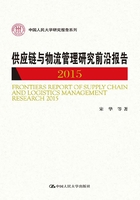
2.5 小结
综上所述,全球供应链管理是一个多角度、多方法的跨学科研究主题,要将其完全综合起来几乎是不可能的。分析层级的不同实际上为我们提出了不同的管理研究问题,例如国家和产业层面研究一方面为政策制定者和政治家们提供制定政策的依据,另一方面为公司管理者处理利益相关者关系提供指导;公司层面研究则为公司战略制定者提出全球采购的比例和离岸外包所在地的问题;关系层面研究则在给定的制度与文化情境下为如何处理供应商和客户关系提出了管理与执行的问题。研究重心这个维度则完全是两阶段决策过程的镜像体现,第一个阶段管理行为和前因就是分析相关情境因素进行决策,第二个阶段管理绩效则是评估决策的影响和绩效。因此,绩效结果一方面决定于供应链设计与执行的匹配;另一方面决定于供应链设计是否与国家、产业和公司的影响因素相匹配。
虽然本章按照这两个维度进行了分类,但是仍不足以将所有该主题的研究包罗进来。此外,根据全球供应链定义,其研究范围非常宽泛,从全球供应链的战略形成到全球供应链的运作管理,从寻找合适的伙伴到与合作伙伴保持合适的关系,几乎涉及在非本国开展业务的方方面面,因此可以说每一个方面的研究如果不充分考虑其外在关联性都是片面的。尽管如此,在全球供应链管理的研究上,仍有针对当前管理实践和理论界比较关注的相对集中的研究主题。比如Anna和Daniel(2013)针对零售企业在国外采购活动进行了文献综述,最后总结出四个当前比较集中的研究主题,分别是区位选择、公司战略、学习及能力开发、伦理与社会责任。延伸到全球供应链的各行各业,通过对2013、2014年全球供应链管理研究文献的梳理分析,现把目前全球供应链管理研究相对集中的研究主题和研究方向总结如下:
(1)全球供应链情境下的风险管理。在全球情境下,空间的跨度较大,不同的国家和地区涉及不同的政策和法律制度,而供应链管理又要求合作伙伴的集成、分享与配合,制度与文化的差异无疑成为风险产生的最重要因素,在供应链设计和管理中就需要加大对风险的认识和控制,通过相互信任与学习的关系构建,有效降低风险指数,保证达到目标绩效。因此,针对全球供应链中相对显著的企业环境异质性、空间与文化距离等风险因素对全球供应链稳定和竞争力的影响进行研究就成为全球供应链管理研究中经久不衰的一大研究主题。Mette和Chris(2013)对供应风险进行了研究,Zhou和Johnson(2014)关注了质量风险,Cruz(2013)、Li等(2013)均对供应链风险进行了全面分析,Jørgensen(2014)和Moe等(2014)则对供应链失败进行了全面分析。针对不同的供应链风险,需要采用不同的风险管理策略与措施,其中学习与能力开发是一个内涵丰富的风险管理战略,能够应对各种供应链风险,避免链中断和失败。
(2)治理结构的全球供应链战略选择。全球供应链管理指的是在全球情境下的供应链管理,作为一种协调、操作、控制和优化的活动过程,其中既有供应链结构模式的战略选择问题——是外包还是在国外建立分支机构,还有关系治理模式选择,即供需之间是结构治理还是关系治理;既有供应链设计问题,也有供应链更新与优化问题。无论是供应链组建还是运行阶段都要进行的定位决策、成本优化等问题,都是全球供应链管理战略关注的核心问题。就像优化永没有终结一样,这方面的研究也永远是大家关注的焦点。例如,构建反应型供应链(Roh et al. ,2014)或者进行应急生产和运送设计(Kouvelis and Li,2013),也或者Hammami和Frein(2014A, B)提出的供应链设计与重构,等等。当然在圈养资源和离岸外包之间进行的供应链治理结构选择也一直是研究热点,Schwarz和Suedekum(2014), Schneider等(2013), Elia等(2014), Jayaraman等(2013)都对这个问题进行了不同侧面的研究。在关系系统中,从供方角度不同侧面的研究也给外包方采取更有效的供应链管理战略提供了参考(Su,2013; Plugge等,2013; Kristj′ansson, 2014)。
(3)可持续性全球供应链管理与绩效。随着环境问题的日益严重,世界各国对环境和社会问题的关注也日益增加,环境问题和社会问题的解决需求渗透到各行各业的管理活动中,全球供应链管理也同样如此。由于全球供应链涉及多个国家和地区,涉及多个产业和企业,因此经济绩效虽然也是其活动目标,但包括环境绩效和社会绩效的可持续性管理目标逐渐成为重中之重。基于此,Jury等(2014)和Ioannis等(2014)对绿色供应链运行与可持续性供应链管理的研究为可持续性绩效目标的获取提供了有益的探索,而Griffis等(2014)有关伦理道德方面的控制也通过供应商选择为可持续性绩效的获取提供了战略选择的参考方向。
参考文献
[1]Abbott P. et al. From boundary spanning to creolization:a study of Chinese software and services outsourcing vendors. Journal of Strategic Information Systems,2013(22):121-136.
[2]Anna Jonsson, Daniel Tolstoy. A thematic analysis of research on global sourcing and international purchasing in retail firms. International Journal of Retail&Distribution Management,2013,42(1):56-83.
[3]Arnaud Costinot, Jonathan Vogel And Su Wang. An elementary theory of global supply chains. Review of Economic Studies,2013(80):109-144.
[4]Bregmanetal. The effect of controversial global sourcing practices on the ethical j udgments and intentions of U. S. consumers. Journal of Operations Management,2015(36):229-243.
[5]Cruz Jose M. Mitigating global supply chain risks through corporate social responsibility. International Journal of Production Research,2013,51(13):3995-4010.
[6]Joshua M. Davis, Carlo Mora-Monge, Gioconda Quesada, et al. Cross-cultural influences on e-value creation in supply chains. Supply Chain Management:An International Journal,2014,19(2):187-199.
[7]Chen Ying-Ju, Deng Mingcherng. Supplier certification and quality investment in supply chains. Naval Research Logistics,2013(60).
[8]Caniato F. et al. The effect of global supply chain configuration on the relationship between supply chain improvement programs and performance. Int. J.P roduction Economics,2013(143):285-293.
[9]Elia Stefano et al. Governance choice and performance in global sourcing of services.Global Strat. J. ,2014(4):181-199.
[10]Fransoo J. C. and Lee C. Y. Critical role of ocean container transport. Production and Operations Management,2013,22(2):253-268.
[11]Griffis Stanley E. et al. Assessing antecedents of socially responsible supplier selection in three global supply chain contexts. Decision Sciences,2014,45 (6).
[12]Hammami et al. A scenario-based stochastic model for supplier selection in global context with multiple buyers, currency fluctuation uncertainties, and price discounts. European Journal of Operational Research,2014(233):159-170.
[13]Hammami R. , Frein Y. Integration of the profit-split transfer pricing method in the design of global supply chains with a focus on offshoring context. Computers&Industrial Engineering,2014A(76):243-252.
[14]Hammami R. , Frein Y. Redesign of global supply chains with integration of transfer pricing:Mathematical modeling and managerial insights. Int. J.Production Economics,2014B(158):267-277.
[15]Handley S. M. , Benton W. C. Jr. The influence of task-and location-specific complexity on the control and coordination costsin global outsourcing relationships. Journal of Operations Management,2013(31):109-128.
[16]Horn et al. Internal integration as a pre-condition for external integration in global sourcing:a social capital perspective. Int. J. Production Economics,2014 (153):54-65.
[17]Ian D. Blackman Christopher P. Holland Timothy Westcott. Motorola's global financial supply chain strategy. Supply Chain Management:An International Journal,2013,18(2):132-147.
[18]Ioannis Mallidis, Dimitrios Vlachos, Eleftherios Iakovou, Rommert Dekker. Design and planning for green global supply chains under periodic review replenishment policies. Transportation Research Part E,2014(72):210-235.
[19]Jayaraman, Narayanan, Luo, and Swaminathan. Offshoring business process services and governance control mechanisms. Production and Operations Management,2013,22(2):314-334.
[20]Jury Gualandris Ruggero Golini Matteo Kalchschmidt. Do supply management and global sourcing matter for firm sustainability performance. Supply Chain Management:An International Journal,2014,19(3):258-274.
[21]Jørgensen M. Failure factors of small software projects at a global outsourcing marketplace.The Journal of Systems and Software,2014(92):157-169.
[22]Kumar Sameer, Boice Brooke C. , Shepherd Mark J. Risk assessment and operational approaches to manage risk in global supply chains. Transportation J ourna l,2013,52(3):391-411.
[23]Manuj, Omar, Yazdanparast. The quest for competitive advantage in global supply chains:the role of interorganizational learning. Transportation Journal, 2013,52(4):463-492.
[24]Kristj′ansson Baldur, Helms Remko and Brinkkemper Sjaak. Integration by communication:knowledge exchange in global outsourcing of product software development. Expert Systems. 2014,31(3).
[25]Kouvelis and Li. Offshore outsourcing, yield uncertainty. Production and Operations Management,2013,22(1):164-177.
[26]Kraiselburd S and Yadav P. Supply chains and global health. Production and Operations Management,2013,22(2):377-381.
[27]Liu Z. AND Nagurney A. Supply chain networks with global outsourcing and quick-response production under demand and cost uncertainty.Ann Oper Res, 2013(208):251-289.
[28]Li Zhao Baofeng Huo Linyan Sun Xiande Zhao. The impact of supply chain risk on supply chain integration and company performance:a global investigation. Supply Chain Management:An International Journal,2013,18(2):115-131.
[29]Mette Vedel Chris Ellegaard. Supply risk management functions of sourcing intermediaries:an investigation of the clothing industry. Supply Chain Management:An International Journal,2013,18(5):509-522.
[30]Miguel Gonzá lez-Loureiro Marina Dabic Francisco Puig. Global organizations and supply chain. International Journal of Physical Distribution&Logistics Management,2014,44(8/9):689-712.
[31]Marsillac E. , Roh J. J. Connecting product design, process and supply chain decisions to strengthen global supply chain capabilities. Int. J. Production Economi c s,2014(147):317-329.
[32]Moe Nils Brede ET AL. From offshore outsourcing to insourcing and partner ships:four failed outsourcing attempts. Empir Software Eng,2014(19):1225-1258.
[33]Niazi M. ET AL. Establishing trust in offshore software outsourcing relationships:an exploratory study using a systematic literature review. The Institution of Engineering and Technology,2013,7(5):283-293.
[34]Plugge A. et al. Outsourcing capabilities, organizational structure and performance quality monitoring:Toward a fit model. Information&Management, 2013(50):275-284.
[35]Pomfret Richard. Expanding the division of labour:trade costs and supply chains in the global economy. Australian Economic H istory Review,2014,54 (3).
[36]Quinlan M. et al. Outsourcing and offshoring aircraft maintenance in the US:implications for safety. Safety Science,2013(57):283-292.
[37]Roh J. et al. Implementation of a responsive supply chain strategy in global complexity:the case of manufacturing firms. Int. J. Production Economics,2014 (147):198-210.
[38]Stine Jessen Haakonsson, Peter D. Ørberg Jensen and Susan M. Mudamb.i A coevolutionary perspective on the drivers of international sourcing of pharmaceutical R&D to India. Journal of Economic Geography,2013:677-700.
[39]Schwarz C. , Suedekum J. Global sourcing of complex production processes. Journal of International Economics,2014(93):123-139.
[40]Steven A. B. et al. Global sourcing and quality recalls:an empirical study of outsourcing-supplier concentration-product recalls linkages. Journal of Operations Management,2014, (32):241-253.
[41]Su N. Internationalization strategies of Chinese IT service suppliers. MI S Quarterly,2013,37(1):175-200.
[42]Schneider et al. Transaction cost economics in global sourcing:assessing regional difference and implications for performance. Int. J. Production Economics, 2013(141):243-254.
[43]Timothy G. Hawkins Wesley S. Randall Adam V. Coyne Mohammad H. Baitalmal. Sustainable integrity:how reverse auctions can benefit suppliers in emerging markets. Supply Chain Management:An International Journal,2014,19 (2):126-141.
[44]Timo SeppäläMartin Kenney Jyrki Ali-Yrkkö. Global supply chains and transfer pricing. Supply Chain Management:An International Journal,2014,19 (4):445-454.
[45]Tomohiro Ara. Global sourcing in industry equilibrium. The J apanese Economic Review,2014,65(1).
[46]Zhou Z Z, Johnson M. E. Quality risk ratings in global supply chains. Production and Operations Management,2014,23(12):2152-2162.